How To Sing Better - The Definitive Guide
My name is Roger Burnley, and on this page I'm going to show you how to sing better... much better than you're able to sing right now.
I think you'll agree with me when I say that it's really hard to develop a great voice.
Luckily there are some simple exercises and tips that can help you improve quickly. This is what I'm going to be showing you on this page.
Why am I the person to help you with this?
Well, I've been a vocal coach for over 30 years. I've helped thousands of singers discover their best voice. Many of these have gone onto become world class singers, selling millions of albums worldwide.
5 Exercises That Will Change Your Singing Voice Forever
Over my long career as a singing teacher, there have been few techniques more effective than the 5 exercises I'm about to show you.
These are the same exercises that my star, Grammy Winning clients use to keep their voices in tip top condition.
No matter what level you're at, by practicing these exercises for 20 minutes each day you will hear wonderful improvements within a few short weeks.
Check out the video below for a brief introduction to this singing exercise series.
Watch The Videos And Then Use The Audio Files to Practice
Below you'll find a video lesson for each exercise.
Watch that first. Once you have a solid understanding of how the exercise is done, use the audio file below the video and give it a go.
Don't be surprised if you feel your range opening up as well as gaining a richness in tone quality.
I know these exercises will do wonders for your singing, as I've seen them work over and over again every day. It doesn't matter if you are a male singer or female singer. They work a treat on anyone who is keen to learn.
Let's get started!
Exercise 1: The Lip Trill
Watch this first and then practice the exercise with the audio file under the video.
And here's the audio file for this exercise so you can practice along.
Let's discuss this exercise a little further...
The Lip Roll

This first exercise is called The Lip Trill or "Lip Roll".
You've probably seen many singers doing this before concerts and in singing competitions on TV.
The reason is, it works like a charm.
Remember The Goal When Practicing The Exercise
The Secret To Star Singing
Click HERE For The Secret To Star Singing
The Secret To Star Singing
Click HERE For The Secret To Star Singing
The goal of doing this exercise and any other exercise is to be able to sing without your voice box moving around too much.
When your technique is a little out, what tends to happen is your voice box will move up and down.
This cuts off your air, which takes away from your tonal quality, limits your vocal range, and restricts the freedom you have.
The Lip Trill Removes Strain And Tension
Why does this all matter?
Well, when you practice the lip trill and your voice box starts to stay relaxed, you'll notice you'll be able to sing through your range with your vocal chords adjusting by themselves to hit each note.
What does this mean?
It means that you'll be singing without strain or tension!
It's the muscles around the voice box that cause the strain and tension, so when they are nice and relaxed singing becomes much easier and more enjoyable.
Practicing The Exercise Will Help You With Your High Notes
In your lower notes and when you speak it's much easier to keep your voice box relaxed.
It's when you sing into your higher notes where it becomes very important to maintain this relaxed state.
When you do this correctly (and the Lip Roll exercise will help you with this), your vocal cords will actually shorten or thin. This makes it much easier to hit higher notes with a full and vibrant tone quality.
Doing The Exercise
In the video above you'll see me demonstrate the exercise. You can also download the mp3's and practice along.
Here's a demonstration that shows how to place your hands when you're practicing.

You'll need use your hands in the beginning, but as you get better you'll notice that you'll be able to do the exercise without your hands on your cheeks.
As you're doing the exercise a great thing to do to help with the placement of your sound is try and keep it above your cheeks.
You may even need to exaggerate the sound to keep it in the area that I'm showing in this demonstration.
You'll know when you're doing this right because you'll have the exercise of hearing your sound in your head. This may not happen right away, but you will get the hang of it with practice!
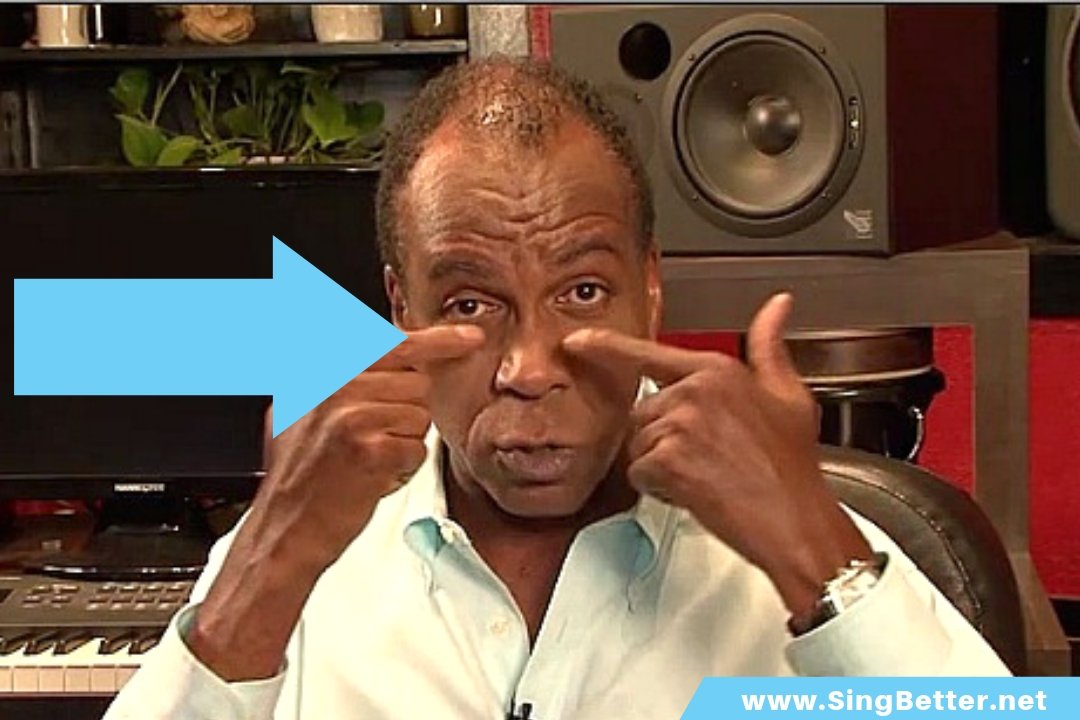 Try to keep your sound focused above your cheeks - This will help keep your swallowing muscles relaxed.
Try to keep your sound focused above your cheeks - This will help keep your swallowing muscles relaxed.Remember Not To Push Your Sound
As soon as you try and push too hard, your voice box will begin moving around, which as you know is bad.
So as soon as you feel yourself pushing your sound, try to back off and make the sound smaller.
Maybe The Best Singing Exercise Ever Created?
The lip roll is one of the most brilliant singing exercises ever invented. If you want to learn how to sing better, this is the place to start.
It helps you eliminate vocal tension. Over time it will increase your range. It frees you up.
In short it begins programming your body to produce sound correctly.
And over time this correct way of producing sound will become automatic to you.
So watch the video above, download the mp3's and begin practicing!
Exercise 2 : The Tongue Trill
The Lip Trill is exercise 1 in this series of the top 5 exercises.
After you've got the Lip Trill Handled, let's move onto the second exercise.
Watch this first and then practice the exercise with the audio file under the video.
Here's the audio file for this exercise so you can practice along.
Learn How To Sing Better - The Tongue Trill

The purpose of this exercise is to get your body experiencing sound without your swallowing muscles coming into play.
This will free you up and give you:
- Better tone quality
- More vocal range
- More freedom
- You'll also find it easier to use different stylistic things like vibrato, licks, trills etc
- In short, it shows you how to become a better singer!
Experience Your Swallowing Muscles
To get an experience of these swallowing muscles, put your thumb under your jaw and swallow.

When you do this, you'll feel these muscles come down, and also move your voice box out of place.
This is what we are trying to eliminate with this exercise.
Cutting Off Your Airflow Blocks Your Voice
Another thing to do is once again, put your thumb under your jaw.
But this time, do a deliberate yawn.
You'll notice when you do this, the muscles will again come down. But also, you'll feel you will be cutting off your air.
This is a big problem for a large percentage of singers, and correcting it will do wonders for your singing.
Let's Do The Exercise
Now, for the best explanation of the exercise you'll need to watch the video up the top of this page.
But the basics are to start with your thumb under your jaw, and to start humming on a scale while allowing your tongue to freely vibrate.
You'll be able to feel when your swallowing muscles are tensing up because you have your thumb under your jaw.
What's With The Funny Face?!
You'll notice me having a funny face when practicing the exercise!
The reason for this is it makes it easier to get the sound to sit above the cheeks which helps you sing without the swallowing muscles coming down.
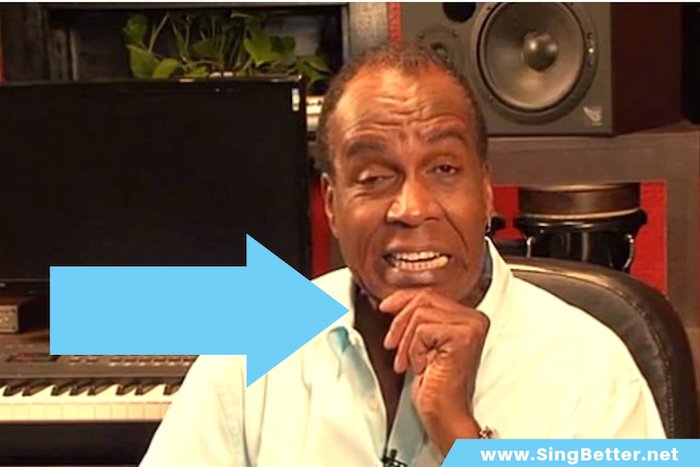
Exercise 3 : Humming
And here's the audio file for this exercise so you can practice along.
This Is One Of My Favorite Exercises!

The major benefit from practising this exercise is it removes your swallowing muscles from the singing process.
It's also a really great exercise if you need a really fast vocal warm up before a performance.
As well, it helps a lot with your tone quality and vocal health, because it trains you to make a really clean and correct sound.
It Gets You Producing Sound With Much More Freedom And Ease
So here's how the exercise is done.
First, place your thumbs under your jaw like so.
 Be sure to keep your thumb under your jaw so you are aware when your swallowing muscles come down.
Be sure to keep your thumb under your jaw so you are aware when your swallowing muscles come down.This helps you feel when your swallowing muscles are coming down. This helps you to let go and relax these muscles.
Then begin humming on the scale. Download the mp3 files just below the video so you can sing along.
You may need to exaggerate the sound to make sure it stays above your cheeks, and doesn't fall back into your throat.
Look at this picture to see where you should be focusing the sound.
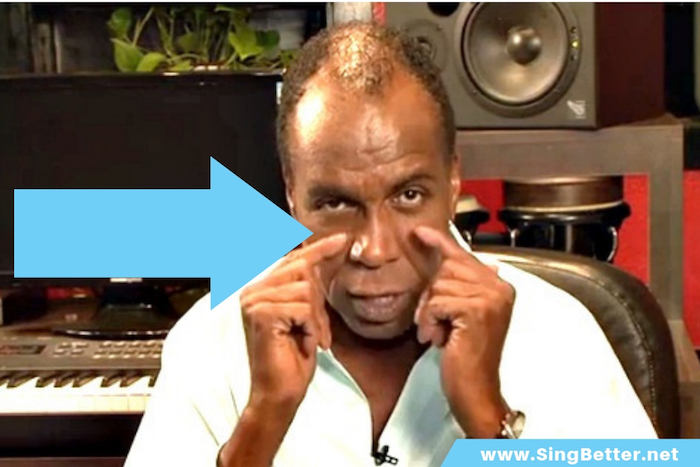
Here's What To Do If Your Sound Fall Apart
If at any stage your sound falls apart, and gets all airy (breaks into falsetto) what you need to do is go back and sing it again using less sound.
Doing it with less volume and less air will make it easier for your vocal chords to stay together, keeping that clean sound.
By practicing over and over again, you'll train your vocal cords to hold together correctly, and then you'll begin to be able to do it at a higher volume.
Freedom!

You'll find after doing this exercise for a few minutes, your you will feel much more freedom.
You'll also feel more control over the notes you are singing.
As an added bonus, your speaking might even feel better too!
Freedom = Control
It's a little counter intuitive, but the more freedom you can give your voice, the more in control of it you will be.
Most people try and control their singing to the point where they get too rigid, and muscles that should not be working get in the way.
Instead if you can unblock your voice so you have complete freedom, you'll have all the control you could ever want.
5-10 Minutes A Day Makes A Big Difference

Just a few minutes of practicing this exercise (and the others in this series) will give you huge improvements over time.
Exercise 4 : Nay Nay Nay Vocal Exercise
Watch this first and then practice the exercise with the audio file under the video.
And here's the audio file for this exercise so you can practice along.
In exercise 4 we are using a "Nay nay nay" sound on a scale that will help you to gain freedom and get your swallowing muscles to relax and release.
Watch the video above for a demonstration.
The reason we are focussing so much on getting these muscles to release is it makes everything so much easier. The swallowing muscles tensing up are one of the things that really blocks a lot of singers (even great ones!).
So the point of this exercise again is for you to experience creating notes going through your range as high as you can get without using these swallowing muscles.
Once again, it's very helpful to put your thumb under your jaw for this exercise so you can have the awareness of when your swallowing muscles are coming down.
It can take some patience to do this perfectly.
It's really about putting in the work. But over time your singing voice will become much better because of this work.
Use Less Sound As You Sing Higher
Another important point is that as you sing higher with this exercise you will ideally use less sound as you go higher. By that I mean you are backing off how much air you are using.
Trying to force too much air through will do exactly what we are trying to avoid, which is engage those swallowing muscles and create vocal strain.
You'll find that your body will respond much better using less air as you go higher into your range.
Record Yourself And Listen To Your Pronunciation Of The Sound

It's a good idea for you to record yourself doing this exercise.
The reason is that if you are tensing up your swallowing muscles, you'll notice that as you sing higher you'll start to change the pronunciation of the sound.
In other words as you sing ‘nay, nay, nay, nay, nay’, if the "Ay" part of the sound starts sounding more like "Ey" (I call this "going wide") this means you are engaging the outside muscles in your neck.
These outside muscles in the neck are connected to the swallowing muscles and the result is they will come down and block your sound.
So it’s going to always pull you out of place and the swallowing muscles will come down. So instead you want to sing ‘nay, nay, nay, nay’,and focus on pronouncing the "AY" part of the sound correctly.
If you record yourself doing the exercise you'll be able to hear very clearly how you are pronouncing the sound. And this will give you the feedback you need to do the exercise correctly.

How To Use Vertical Hearing
A good tip for keeping the pronunciation of your Nays on point is to use what I call "Vertical Hearing".
This means to focus on hearing your sound in your forehead. And also try to keep your sound going up and down in a vertical line in front of your face.
This is really just a mental exercise. And while it might not be technically what's happening to the sound, it's an excellent tool to keep everything in good place.
You'll find by doing this you will be able to sing with your "Nays" up and down your range keeping the pronunciation consistent and correct.
Vertical hearing is a singing lesson that took me decades to discover and to this day is still one of the best tips I know!
Let's Talk About Hitting Your Lower Notes
We've just discussed how as you sing higher your "Nay" sound might start to widen in it's pronunciation. And we've gone over some tips to correct this.
The other bad habit that is common with this exercise is what happens when you are singing your lower notes.
Often singers will feel their sound fall back into their throat as they go lower.
Once again, the result of this is your swallowing muscles coming down and blocking off your sound.
An excellent tool you can use to help prevent this is to try to experience your sound above your cheeks a bit more.
To do this, here's another little mental exercise you can use:
Instead of thinking you are singing down to the note, flip it around and "think" that you are singing up into your lower notes.
It might feel a little strange at first, but with some practice you'll find that by thinking you're singing up into your lower notes, you'll experience more of your sound above your cheeks.
Doing this will will give you a lot more freedom your lower range.
Getting Through Your "Break" Without Your Voice Falling Apart
Now, you’ll experience places range where you go through what we call a break.
Your "break" is the place in your range where you’ll feel a very definite shift in the tone that you are getting.
The key in getting through your break and into your upper vocal range is to not disconnect into a falsetto sound.
Your falsetto is what happens when your vocal chords or vocal folds come apart and your sound develops a very airy like tonal quality. It also loses a lot of the tonal depth.
So instead you want to keep your chords connected as you sing into your upper range.
If you watch the video above you'll see me demonstrate singing up into my higher notes, and as I'm doing this I can feel my sound resonating in a different place, but the vocal cords are still together.
It's very important to keep this connection with your chords. In the long run you will have a lot more control and tonal depth because of it.
Release Into Your Higher Notes
Another great trick to use with this Nay Nay Nay exercise is to think to yourself that you are "releasing" or "letting go" into your higher notes.
Once again this is about creating a little mental picture that will help your body to physically produce your sound the way it was designed.
The reason this one works is singers often associate their high notes with, "I've got to really go for those notes", which leads to pushing and engaging all the muscles you don't need.
By thinking that you're releasing into your higher notes allows you to let go as you sing higher.
Let's now move onto the fifth exercise, which is using a descending scale.
Exercise 5 : Descending Scale
The last exercise in this series is a very effective one.
Exercise 5 is the same one we used in Exercise 4 but we are just doing a descending exercise on a descending scale.
Here's the audio file (this goes into the Descending part of the scale at 1:20)

Now, again as I explained earlier the value of this is for you to start to train your body to go into your lower notes without falling back into your throat.
Your brain is very smart and that's why these little mental pictures work so well.
When your brain hears where the note is that you're going for it will actually tell your vocal chords or vocal folds what size and shape it needs to form to match that note.
Once again, it's a very good idea to find something you can record yourself with (like a smart phone) and then play back yourself doing the exercise.
This gives your brain even more feedback and it will naturally make adjustments just from hearing what you are doing.
It Can Take A Little Time To Reverse Bad Habits
If you've been used to singing and creating sound in a particular way for a long time, it may take a little time for these exercises to sink in.
This is another reason why recording yourself can be so valuable. If you've been doing a certain thing for a long time, you may not notice you're doing it until you hear it played back.
As long as you are persistent, with practice and listening back to yourself, the bad habits will fall away and become replaced with solid technique.
Try Using Other Sounds Than "Nay Nay Nay"

Once you start to master the exercise doing it on the ‘nay, nay, nay’ it then becomes really valuable to do the same exercise, the same pattern on different sounds. This is another very good one of my tips on singing better.
Each different sound you use will have a different impact on your singing and give you a different benefit.
For example, using the sound "Mum" is something that will have the tendency to fall back in your throat.
So using "Mum" will help you practice trying to experience your sound above your cheeks.
You'll find using "Mum" is a slightly more advanced exercise than "Nay". So it's important to first master "Nay". Then move onto "Mum" and try to get to the point where you don't feel your swallowing muscles come down.
The Two Parts Of Your Tonal Quality
Now let me explain why these sounds (Nay, Mum) works so well.
There are two parts or components of your tonal quality.
There’s the ‘eh’ edgy sound which pulls up in the muscles and the larynx. This sound typically comes out when doing the scales on the word Nay.
Then and then there is ‘ah’, a rounder sound that has almost a yawning quality to it. This comes out in the word Mum and it will typically pull your larynx down slightly.
So what you are trying to do is find the balance between those two sounds that will allow your larynx or your voice box to stay more relaxed and more in place.
Once you start to master this, again you’ll feel so much more freedom.
There are other sounds you can use too that will give you different challenges.
‘We, we, we’ is a great one because W's give people a lot of trouble. So if you're able to successfully sing the exercise using this "We, we ,we" sound you know you'r in a good place!
If you find the "We" sound challenging a good tip is to add more of the ‘e’ sound and you’ll create that ‘eh’ edgy sound that you've developed from practicing "Nay nay nay".
This will help make the "We" sound much easier to achieve.
Teaching Yourself How To Sing Better - Practice These Exercises Long Term
Consistent daily practice is the number one way the brain and body can learn and improve.
Often you will find when you do a new exercise it will feel very difficult at first. The first practice session is usually frustrating because you don't feel like you're close to doing the exercise well.
But don't worry!
In the time in between each session your brain will be ticking over. Processing. Piecing things together.
When you come back for a second session on the exercise things will feel a little easier. Maybe not perfect yet. But definitely improving.
By the third or fourth session your brain and muscle memory will be really getting the hang of it. What seemed impossible a few days earlier is now feeling much easier!
So the key is to stick with it! This is how you will become a better singer.
Practicing these exercises 20 minutes a day or every few days will lead to incrementally gaining more freedom and vocal range.
Each time you begin to gain more mastery over an exercise it will bring new abilities to your singing.
And with consistent practice, you'll feel the quality of your singing gradually increase more and more.
So be patient with these exercises and voice lessons. Have fun!
Do this long term and you will develop a voice you love using that you're proud of.
Ok, so now that you have a great exercise schedule to follow, I'd like to share some of the best singing tips I've learned over my lengthy coaching career.
Some of these tips took me many years to learn, so pay attention!
Let’s start at the start. This video will build upon the knowledge you've learned so far in this tutorial.
Let's go through the main points.
Tip 1: Understand How You Create Your Sound
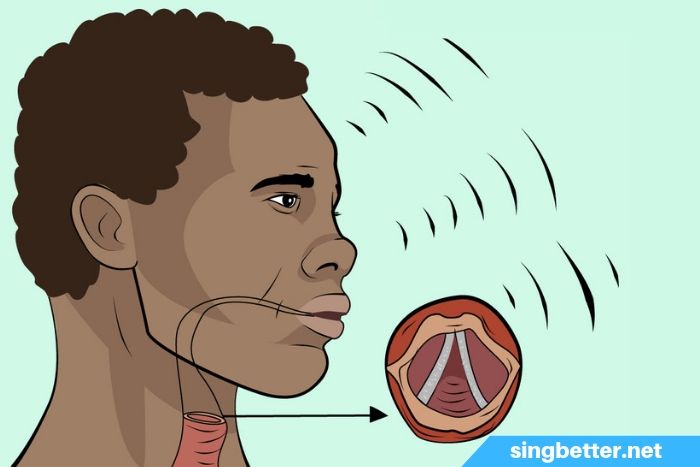
A basic understanding of how you create your sound is a great starting point when learning how to sing properly.
Inside your neck you have a voice box that has your vocal chords (or vocal folds).
When you sing, you are pushing air through your voice box which allows these vocal chords to move back and forth.
This “vibrating” from your chords causes sound waves to move upwards. The sound then gets amplified as it moves up through your head.
For a more in depth discussion of how you create your sound, check out this tutorial.
Use Exercises That Keep Your Voice Box Stable

The next tip is about learning how to sing without straining.
When you’re first learning to sing one of the best things you can do to get your technique off on the right foot is to keep your voice box stable.
The funny thing is, just about the biggest mistake that singer make - from beginner singers to seasoned pro’s - is they move their voice box around as they sing.
By keeping it stable, you will have more control and you won’t be blocking off your sound (which is what happens when it starts to move around).
One of the easiest ways to tell if your voice box (or larynx) is moving around when you sing is if you are feeling strain.
If you feel like you’re having to “push” get a note, it probably means your voice box is moving out of place.
When this happens, the best thing to do is back off. Sing in an easier range that feels more comfortable.
When you are first learning to sing, it’s important to do exercises that feel comfortable. And exercises that don’t cause you to develop bad technique.
How To Sing For Beginners - Humming Exercise

Humming is a very good exercise to start your singing journey. By taking a song that you like and humming over the melody, you will begin to experience using your voice.
You can also take scales to practice your humming.
Scales are a series of notes that musicians use to practice their technique.
Humming on easy scales will help you begin to get familiar with different parts of your voice. This will then lead on very naturally to doing more difficult exercises.
Here is a scales you can practice humming on.
Develop Your Internal Hearing

Another thing that will be very valuable to you in the beginning is to develop your internal hearing.
This means that you can hear the notes that you want to hit. And also, that you can recognise when you are singing in tune, or out of tune.
This will help you learn how to sing in pitch.
Now, If you feel like you are tone deaf, don’t worry!
I’ve proven over and over again with private clients that with practice, anyone can begin to hear the notes!
One client in particular appeared to be the most tone deaf person I’d ever met!
Yet he was desperate to perform for his girlfriend as a special anniversary present.
So for hours I would play notes on the piano and then he would try to match them.
Slowly but surely he began to hear each note. It took some time, but in the end he was able to hear every note very clearly. This experience showed me that being tone deaf is something that can be overcome.
So if you can’t hear the notes very well, there are a few things you can do to fix it.
If you have access to a piano, start playing keys one by one and then see if you can match the pitch.
Take a song that you know very well and listen very carefully to the notes. See if you can sing parts of it in tune.
To learn a few more of my tricks for singing in tune, check this tutorial.
Advanced Tip For Developing Your Internal Hearing

When you are listening to the notes, try to hear them at the middle point in your forehead. I have found that for singers, this is a great place to focus on your sound.
As you sing, this is where a good amount of your sound passes through, so concentrating your hearing on this position is a very effective tactic.
Developing your internal hearing, like any other skill, can be developed with practice. Use the ideas I’ve just discussed and before you know it, you’ll be able to hear the notes perfectly!
Blend Your Vocal Registers Together

Your Vocal Registers are the different parts of your voice.
The most common way to categorise the different registers are like this:
Head Voice - The top part of your vocal range. In other words, your higher notes. Your head voice is usually a sweeter, “hooty” type quality. For more detail on how to sing in head voice, check out this tutorial.
Chest Voice - This is the lowest part of your range. It’s the register you use to speak. It has a thicker, more powerful tonality to it.
Mixed Voice - This is in the middle part of your range. It’s where you’ll sing most of the time. It’s called mixed voice because you’re blending your chest and head voices together.
I like to put a large focus on blending all of these parts of your voice together as you move up and down throughout your range.
So even if you are at the very top of your range, or the very bottom, you are still blending between chest and head voice.
This is a more advanced concept, but the exercises we will go through soon will help you to understand and develop this further.
Don’t Reinforce Bad Habits (If you find yourself pushing - stop!)
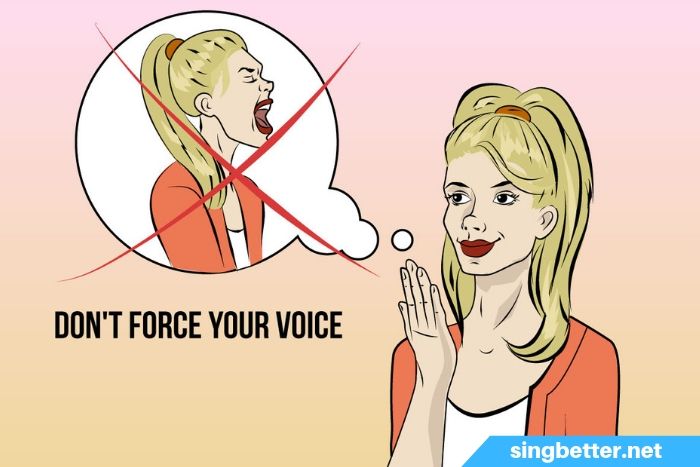
When you are developing as a singer you want to avoid developing bad vocal techniques.
Bad techniques will make you sound unprofessional. And they are going to limit your range as well as give you a sore throat!
The good news is, it’s usually easy to tell if you’re singing with bad vocal technique.
How is this?
Well, it will either feel uncomfortable… or it will sound bad!
So if either of these things happen the thing to do is stop doing what you are doing!
Instead, go back to something that feels comfortable. It’s much better to practice things that are easier to sing. This way, you are developing solid technique that will help you begin to sing things that are harder later on.
Usually the areas where singers reinforce bad technique are:
- They try to sing higher or lower than they are currently capable of
- They try to sing with more power than they are currently capable of
The key is to be patient! Remember that there is no such thing as a bad singer. Bad singing just means bad technique. And technique can be worked on! If you can’t currently sing something comfortably, it doesn’t mean you won’t be able to in the future.
Keep practicing in areas of your range that are comfortable and over time your abilities will gradually expand.
But be careful to not push things to where it’s not comfortable.
Create More Freedom

A great goal to aim for is to be able to sing with as much freedom as possible.
When you have freedom you’ll be able to sing more songs, more easily.
So how do you get more freedom?
Well, the answer is to remove everything that is blocking your voice!
The thing that I’ve personally found to cause blockages more than anything else is the swallowing muscles.
Your swallowing muscles are very good at helping you eat food! But when it comes to singing they can really cause problems.
To know if your swallowing muscles are interfering with your singing, you can put your thumb under your jaw while you sing.
Now, when you are singing a song you’ll be able to feel if these muscles tighten up.
If they do (and there’s a very good chance as it happens even with the most seasoned pro’s!) this means you are losing freedom.
You can gain freedom by learning to relax these muscles as you sing.
By checking in once in a while (by placing your thumb under your jaw) you will become aware of when you are tightening up these muscles.
Over time, this awareness will lead you to relaxing these muscles and singing with much more freedom.
Place Your Sound In Your Mask

Placement is very important when you sing.
What “placement” means is where you are projecting or “placing” your sound.
Your placement will have a big impact on the quality of vocal tone that you produce. It will also have an impact on how much freedom you have when you sing.
To place your sound for the most freedom and tone quality, it’s best to sing into your mask.
Your mask is the front of your face.
Ideally if you try to focus your sound so it’s resonating above your cheeks in the front of your face.
Once again, a good singing technique you can use is to try to focus your sound into a point in the middle of your forehead.
This will help you keep your placement in check.
Backwards Thinking
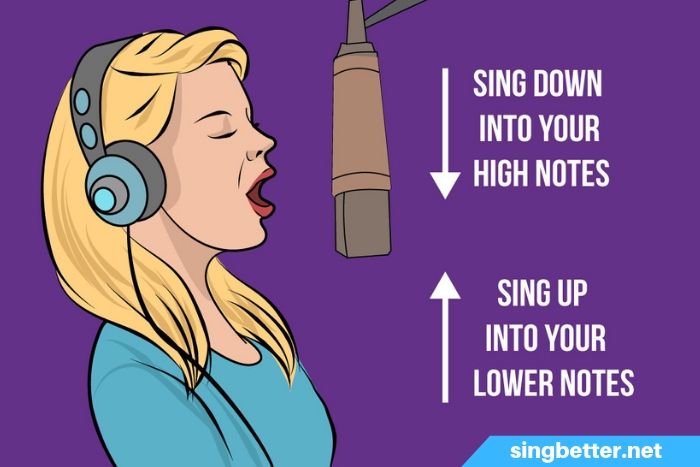
This next tip is counter intuitive, but boy does it work!
The big idea is to “think backwards” as you sing.
This means that if you are singing a high note, you think that you’re singing down into the note.
And if you are hitting a low note, think that you are singing up into the note.
It’s a little tricky at first because you might be used to trying to sing up to your high notes and sing down into your low notes.
What this new way of thinking does is it keeps your voice box nice and relaxed and stable.
You might remember at the beginning of this tutorial we talked about how one of the fundamental pillars of singing is a stable voice box.
This “backwards thinking” will help you with this more than just about anything else.
The reason is because when you’re thinking that you’re singing down into your high notes, it keeps you from reaching up to them.
And when you are thinking that you’re singing up into your lower notes, it keeps you from your sound falling back into your throat.
This idea takes a little practice, but after a while it becomes very natural. And when it does you will find singing much easier. And if you're wondering how to sing high notes easier, this tip will help you more than anything else.
Sing Like Only You Can

The main thing about being a singer and and artist is being original. Authentic.
You must be who you are!
I have so many singers who come to me and say, "I want to sound like "insert famous singer here"...
When this happens I always think, "why would you want to do that"?
The reason I think this is because we already have this other singer!
Who we don't have is YOU!
I know this goes on a lot because of all these singers who ask me... and also because when I was young I did this myself! I would try to copy and imitate the singers that I loved and admired, trying to sound like them.
And because of that I also started to form some very bad habits.
There's something I want to tell you now that I firmly believe, and I've proven it again and again over the years.
Everybody has a great singing voice!

EVERYBODY.
The only reason you don't right now is because there's something that you are doing physically that's blocking it from coming out.
I tell my clients all the time, when you come in I'm not teaching you how to sing.
What I'm doing is getting everything out the way that has been blocking you from singing great.
When you start to find your true voice, it will sound great and beautiful. And it's not going to sound like anybody else.
This is why you can recognise different voices from your family and friends. Everybody has a special sound unique to them.
It's your job to discover and work on yours.
Now, let's go over some very important things that will help you that have nothing to do with technique. This video goes over 4 very important tips that will help you achieve your singing goals.
Mindset

One of the most important things you can do to become a great singer is to have a positive mindset.
Singing is one of those things where most people assume that if they can’t sing naturally, there’s no way they’ll ever be any good.
So it’s very normal in the beginning to think things like:
"I don’t have the ability to sing now, so I’ll never be able to”.
Another common thought that singers with a little more experience have is:
“I’ve hit the wall of my ability and I can’t get any better”.
After coaching thousands of singers I can tell you that this type of thinking is completely false.
Can Anyone Learn How To Sing?
Anyone can learn to sing! Learning to sing is quite simple. It's about physically creating sound in a way that sounds good. And like anything physical, with repetition, you get better at it. With a few good exercises (found on this page) and some basic understanding, any person or non singer can learn to sing.
And no matter where your voice is right now, it can get better.
I’ve found with even the biggest star singers, there’s almost more. More improvement. More freedom. Better tone.
So if you are at the beginning of your journey, or you feel like you’ve hit a wall in your development, here’s an idea I’d like you to think about.
Try to suspend your disbelief. In other words, push away that little voice that says, “you can’t do it”. And instead, realise that you can become a very good singer as long as you’re willing to work at it. You could even become a professional singer.
Don’t base your idea of your potential on what you're currently hearing. Understand that you have a great amount of potential that’s currently untapped.
And remember that singing is a physical process.
And that if you learn how to produce sound correctly, you will sound great!
I’m sure there’s been something you’ve done in the past where it was slow going in the beginning, but you stuck at it. And over time you developed and became quite good!
If you can think of something like this, draw on it now for inspiration.
This tutorial you are reading right now shows you just about everything you need to know how to teach yourself how to sing. So stick with it and you will get there!
Practice (duh!)

The biggest thing that will affect how quickly you develop is how regularly you practice.
It’s very obvious but it’s 100% true!
The saying “practice makes perfect” couldn’t be more true when it comes to singing.
Because what you’re developing is muscle memory. And the way you develop muscle memory is by repeating things over and over again.
So one of the best things you can do is decide on a practice schedule. This means sitting down and figuring out when and where you are going to practice.
It’s a good idea to start with a nice easy schedule that you know you’ll be able to stick to.
If you try to bite off more than you can chew by trying to practice hours a day, you’ll very likely burn out and give up.
But if you decide on a schedule that won’t be too difficult to keep up, it will be easier to stick to. And then as this schedule becomes a habit… and you begin to feel excited about your development, you may decide to increase your practice time.
A good starting point is to do a 20 minute practice session 2 days a week.
A final piece of advice for developing a practice routine…
A good plan that’s executed is far better than a perfect plan that never happens.
So choose a schedule! It doesn’t need to be perfect. Go with what you feel and then adjust from there.
Persistence

Another very important thing for becoming a singer is to develop persistence.
The thing about learning something new is it’s not always easy.
It might feel confronting at first.
It might be uncomfortable. There might be other things that you would rather be doing.
You may not always feel in the mood to keep going and practicing.
My advice is to stick with it!
Learning to sing is a very enjoyable and rewarding pastime. And if you have chosen a practice schedule like we talked about earlier, you will definitely improve!
And as you improve you will have more fun, and begin to get excited about the possibility of doing all the great things singers get to do… Like performing… singing in groups/choirs… recording… joining bands… singing at church and other community events.
It is totally worth it, so persistence until things get easier is very important.
The thing that will help you persist the most is to develop a regular practice schedule. If you keep this up long enough it will become a habit and there will be much less resistance when it comes time to practice.
It can take time to sing well. But consistency gets great results, so stick with it and you’ll be rewarded for your efforts.
Patience

Learning to sing is an ongoing development. Like anything worthwhile, it can take some time before you start hearing results you like.
So it’s important to be patient.
I’ve known a great many singers who started to make good progress, but then given up because they didn’t think they were improving fast enough.
If you’re feeling like you want to give up or you’re frustrated that you don’t sound how you want it to, here’s what to do.
First, take a deep breath… Relax!
And start thinking about that great singer that you want to be. Think about what it will allow you to do. The exciting performances you’ll be able to give. The audiences you will be able to entertain.
If this thought still excites you, it’s important to keep going!
Be ok with where you are, and know that as long as you keep practicing you will get better.
And try to have fun with your singing, not matter what point you are at!
One way of doing this is to use songs that you enjoy when you are practicing. This means that your singing practice is really just an excuse to listen to your favourite music!
Ask for help
If you’re not getting the results you want, find someone who can help you.
This might mean using websites like this one to find online singing lessons. There are many great online videos and courses available where you can learn a great deal.
And if you try this and don’t find yourself improving, or keep hitting the same challenges, it might be time to find something more individual.
This means finding a coach who understand what you are doing as well as how to correct any mistakes or bad habits.
You see, everyone has a slightly different voice.
Males tend to have heavier voices that go lower, and females tend to have lighter voices that go higher.
But there are many exceptions to this too.
The thing to remember is that your singing is a little different to everyone else, so if you keep having problems you may need someone to hear you and give you specific feedback.
Embrace The Nerves

Part of singing is performing.
And performing brings up all kinds of nerves, fears, and insecurities.
The best thing you can do is realise that all of these things are just energy. It comes with the territory of performing and you’ll probably never do a performance without getting nervous.
So embrace it and realise this energy will actually help your performance.
When you do this you’ll find these nerves can easily transform into excitement.
Be Confident And Tell Your Story

Here’s a big secret. The audience really aren’t that fussed about you hitting every note perfectly!
They would much rather be told a story. Given an experience.
And the way you can give this to them is to commit to your performance. Become less concerned with being technically perfect and more concerned with communicating.
What are the songs you are singing about?
Look at every lyric and figure out what emotion/feeling/story you are communicating.
And then deliver that to the audience.
Be confident!
And if you don’t feel confident, pretend that you are!
(If you are feeling really nervous, moving around a lot can help hide this)
As you work into your performance you’ll hit a point where you'll relax a bit and the confidence will come.
Have Fun!
In the end singing is all about having fun.
So make sure to enjoy yourself!
Of course, learning something new and getting good takes time and effort.
But you can do little things that will keep things enjoyable.
For example, you can use songs that you enjoy singing to practice to.
You can schedule in small performances now and then to have something to look forward to.
Set goals that excite you and reward yourself when you tick them off.
Is It Possible To Learn How To Sing?
I'm sure you can see from everything I've shared in this vocal training tutorial that even if you've never sung a note in key in your life - it's very possible to teach yourself how to sing and develop significant singing skill.
So if you're an aspiring singer I hope some of these tips will help you understand how to sing better as learning to sing is well worth the effort.
Leave me a comment below and let me know which tip resonates with you the most!
About The Author
 Roger Burnley - Vocal Coach Roger Burnley - Vocal Coach |
Roger Burnley is a vocal coach located in Hollywood, California. He has been teaching singers for over 30 years and singing for even longer than that.
Notable past and present clients include Macy Gray, Brandy, Ray J, The Beastie Boys, James Torme, Taylor Lautner, Nona Gaye, and many more.
His clients have collectively sold more than 30 million albums, with several reaching Platinum and Gold status.
Roger has been featured on VH1, TV Guide Channel, TV One,
and MTV appearing as a vocal expert.
About The Author
 Roger Burnley - Vocal Coach Roger Burnley - Vocal Coach |
Roger Burnley is a vocal coach located in Hollywood, California. He has been teaching singers for over 30 years and singing for even longer than that.
Notable past and present clients include Macy Gray, Brandy, Ray J, The Beastie Boys, James Torme, Taylor Lautner, Nona Gaye, and many more.
His clients have collectively sold more than 30 million albums, with several reaching Platinum and Gold status.
Roger has been featured on VH1, TV Guide Channel, TV One,
and MTV appearing as a vocal expert.


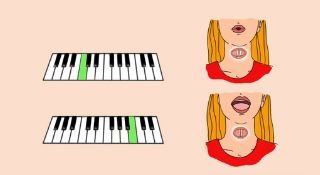






New! Comments
Show me you're alive! Leave a comment below...